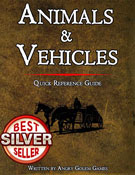Medium beast (animal), unaligned
Armor Class 10
Hit Points 11 (2d8+2)
Hit Points (suggested) 16 (3d8+3)
Speed 40 ft.
Proficiency Bonus +2
Proficiency Bonus +2 (5th Edition Advanced Mode)
| STR | DEX | CON | INT | WIS | CHA |
|---|---|---|---|---|---|
| 14 (+2) | 10 (+0) | 13 (+1) | 2 (-4) | 10 (+0) | 5 (-3) |
Senses passive Perception 10
Challenge 1/8 (25 XP)
Beast of Burden. The mule is considered to be a Large animal for the purpose of determining its carrying capacity.
Sure-Footed. The mule has advantage on Strength and Dexterity saving throws made against effects that would knock it prone.
ACTIONS
- Multiattack (suggested). The mule can make two attacks, one with its bite and one with its hooves.
- Bite. Melee Weapon Attack: +4 to hit, reach 5 ft., one target. Hit: 3 (1d2 + 2) bludgeoning damage.
- Hooves. Melee Weapon Attack: +4 to hit, reach 5 ft., one target. Hit: 4 (1d4 + 2) bludgeoning damage.
DESCRIPTION
A mule is a hybrid animal that results from breeding a male donkey and a female horse. Mules are typically sterile and cannot produce offspring of their own. Mules are valued for their strength, endurance, intelligence, and sure-footedness. They can carry heavy loads over rough terrain and resist diseases and parasites better than horses. Mules vary in size and appearance, depending on the breeds of their parents, but they usually have long ears, a short mane, a thin tail, and a brown or gray coat.
COMBAT
Mules are not aggressive creatures, but they will defend themselves or their companions if threatened. They can kick with their powerful hooves, which can inflict serious damage to smaller foes. Mules are also adept at avoiding attacks that would knock them prone, such as trips, slides, or pushes. Mules can be trained to accept riders and pull vehicles, but they are more stubborn and independent than horses. They will not obey commands that go against their instincts or put them in danger.
HABITAT / SOCIETY
Mules are domesticated animals that live in farms, stables, or caravans. They are often used as pack animals or mounts by travelers, merchants, adventurers, or soldiers. Mules can adapt to different climates and environments, from deserts to mountains. Mules are loyal and intelligent creatures that can form bonds with their owners and other animals. They can also communicate with each other and with donkeys and horses through vocalizations and body language.
ECOLOGY
Mules are herbivorous animals that feed on grass, hay, grains, fruits, and vegetables. They need fresh water and shelter to survive. Mules can live up to 40 years or more in captivity. Mules have no natural predators, except for humans who hunt them for their meat, hide, or bones. Mules have a low impact on the environment, as they do not overgraze or damage the vegetation. Mules are also useful for transporting goods and people across long distances without relying on magic or technology.
Mules can be used as mounts or pulling animals for vehicles.
The statistics are detailed in the D&D 5e Animals & Vehicles reference guide. Just have a look at the preview on DrivethruRpg.
